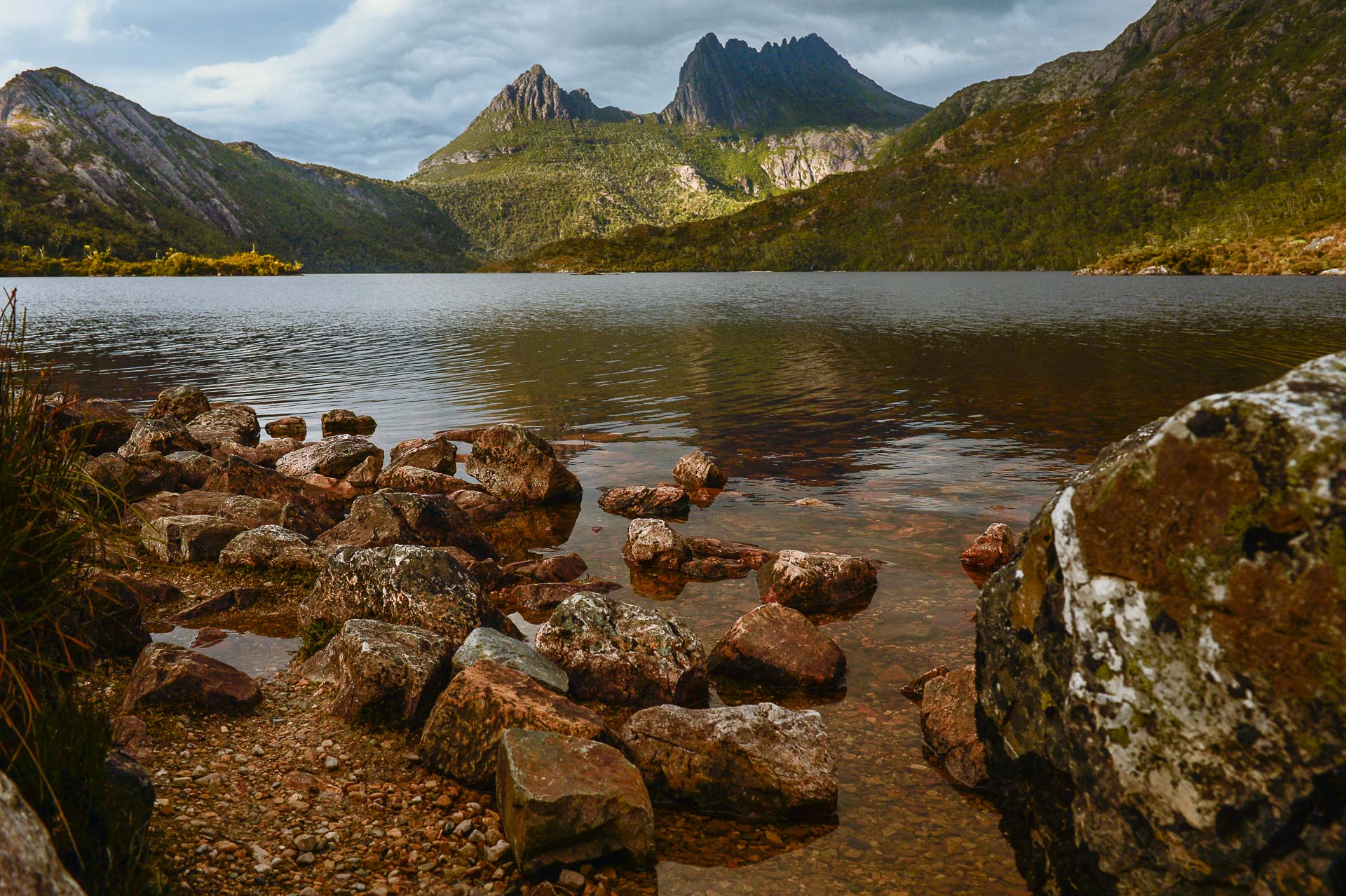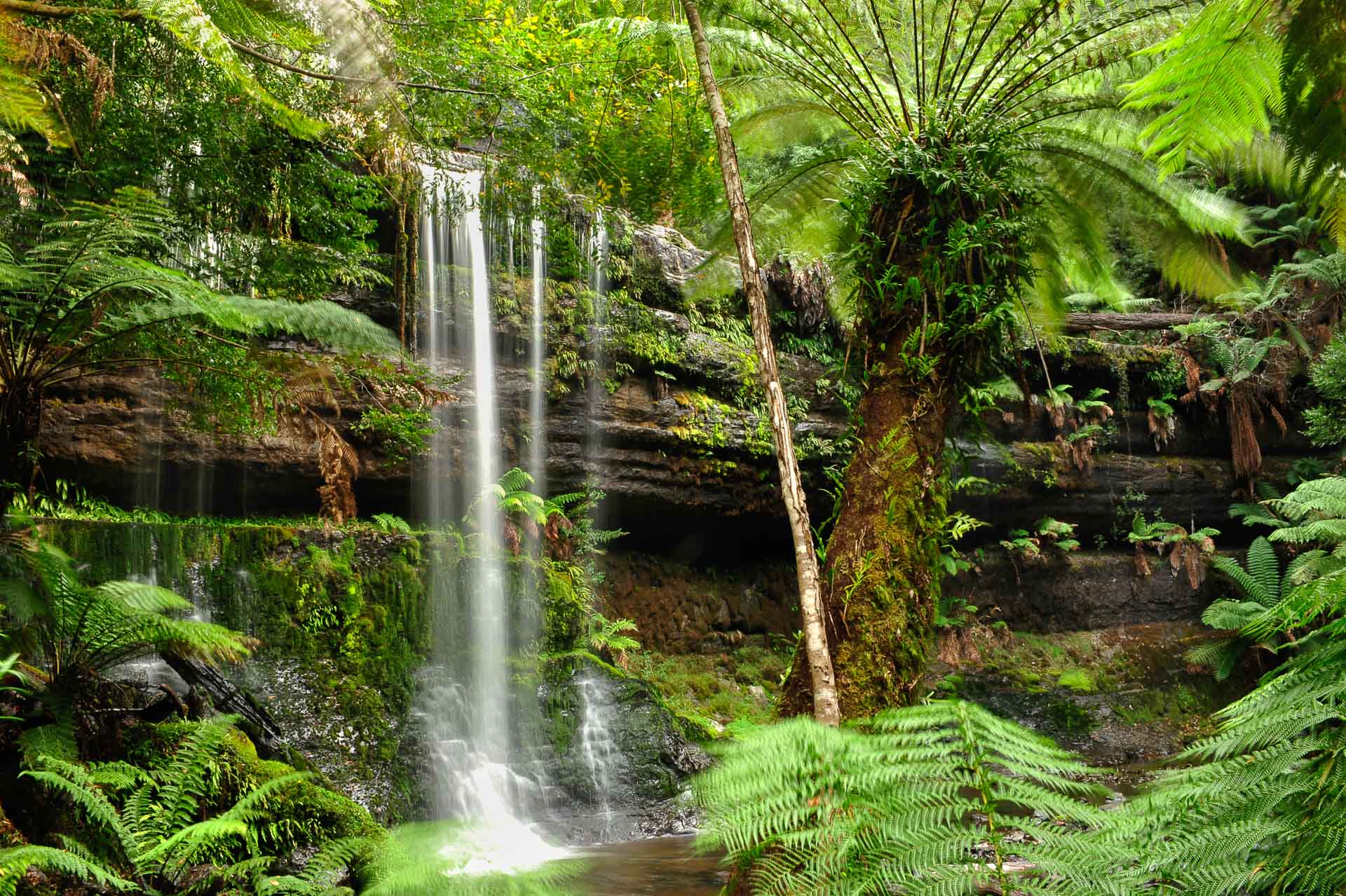As far as natural beauty goes, it’s hard to beat the Apple Isle. Take a tour of Tassie’s most stunning landscapes.
WORDS Andrew Bain
Tasmania’s natural credentials are impeccable. More than 40 per cent of the state is protected from development in the form of national parks and reserves, with half of that area listed by UNESCO as World Heritage wilderness.
There are numerous natural landmarks here – including Wineglass Bay and Cradle Mountain – and such a treasury of natural wonders that it’s hard to believe they all fit onto one small island.
Tasmania is at its shapely best at Wineglass Bay, the crescent beach precision-cut into the neck of the Freycinet Peninsula on the state’s east coast. It’s a staple on lists of Australia’s best beaches, with its perfect white sands framing one side of a narrow isthmus and the pink-tinged Hazards mountains rising directly from its shores. You’ll often see wallabies wander down onto the sands, and the waters stir with dolphins. It’s like a tropical idyll with a far-southern address.
Shape is similarly the defining feature of Cradle Mountain. Tasmania’s sixth-highest peak is also its most famous, and for good reason, with the mountain’s dramatically bowed summit forming the ‘cradle’ figure of the name.

You’ll enjoy the best views of Cradle Mountain from the shores of Dove Lake, the gorgeous alpine waterway pooled across its base. A 6km walking track circuits the lake, lending you lingering looks at Cradle Mountain’s commanding cliffs, and passes through the equally impressive Ballroom Forest, an ancient stand of rainforest smothered in moss.
Travel to the north-west coast and an imposing remnant of an ancient volcano seems to rise out of Bass Strait long before you reach it. Towering above the fishing town of Stanley, The Nut is the remains of a volcanic plug – a section of hardened magma from inside a volcano. When the rest of the mountain eroded away, the 143m-high Nut remained.
The Nut’s flat-topped summit can be reached on a chairlift, and its lower slopes double as a home to little penguins, which march ashore at its base each evening (head to a viewing platform at the end of Godfreys Beach to watch the parade).
A short distance west of Stanley, at Tasmania’s north-west tip, is Cape Grim. You might not be able to immediately see what’s so special about this cape, but you sure can sense it. An air pollution station on the cape, run by the Bureau of Meteorology and CSIRO, has deemed that the air that blows through here is the cleanest on the planet. It shouldn’t be surprising – before arriving at Cape Grim on the Roaring Forties winds, this air has travelled for thousands of kilometres across unbroken stretches of open ocean.
Purity is also the defining feature of the Gordon River. Flowing through the Tasmanian Wilderness World Heritage Area and out into Macquarie Harbour – six times the size of Sydney Harbour – the Gordon runs for 170km and yet it’s crossed by only one road. At its lower end, it’s accessible only by boat, with river cruises out of Strahan drifting through the perfect rainforest reflections.
Gordon River cruises make a stop at Heritage Landing, where a boardwalk leads to a stand of Huon pines more than 2,000 years old. These endemic Tasmanian trees, long cherished for their superb timber, are Australia’s oldest trees (and the second oldest in the world), with an ability to grow for more than 3,000 years.
Watery wonders continue across Tasmania’s south-west wilderness. At the southern edge of Cradle Mountain-Lake St Clair National Park, Lake St Clair is Australia’s deepest lake, plunging to a depth of more than 200m. If you stand quietly on its shores, there’s a chance a platypus will appear.
Waterfalls pour over hundreds of cliffs across the state, and prime among them is Russell Falls, which holds a special place in the history of Tasmania’s natural preservation. In 1885, the falls were protected as the state’s first nature reserve (just six years after the establishment of Australia’s first national park), and in 1916 they became the centrepiece of the state’s first national park, Mount Field.

The trail to the falls passes beneath some enormous trees, which are a trademark of Tasmania’s wilderness. Growing through lush valleys across the island’s south are towering mountain ash trees, also known as Eucalyptus regnans. The tallest flowering plants in the world, these forest giants soar above every other tree – you’ll find the world’s tallest, Centurion, rising 100m from the ground in Tasmania’s southern valleys.
Not far from that tree, the Tahune Airwalk will provide you with a heady look into this high forest canopy. The Airwalk’s 600m-long elevated metal boardwalk ascends 30m above the forest floor, providing a literal bird’s-eye view of the forest. At its end, a cantilevered platform hangs 50m above the Huon River for a truly wild view of this fantasy forest.
Even taller than Tasmania’s trees are its cliffs. The state’s south coast has the highest sea cliffs in the Southern Hemisphere, rising 300m above the ocean. Among the loftiest are those along Bruny Island’s east coast, running from Fluted Cape to the southern tip of the island.
Gliding past these cliffs on a boat trip provides neck-craning perspective as well as the chance to edge out into another Tasmanian wonder – the Southern Ocean, the vast body of water which is all that stands between Bruny Island and Antarctica.
The presence of a large colony of Australian fur seals swimming beneath towering sea cliffs, with nothing but 2,500km of cold and chaotic ocean stretching to the south, seems only to enhance the feeling that nature has the final word in Tasmania.
Explore more stories like this one in our Beyond Magazine. Download or request your copy today at www.journeybeyond.com/inspiration/journey-beyond-magazines/